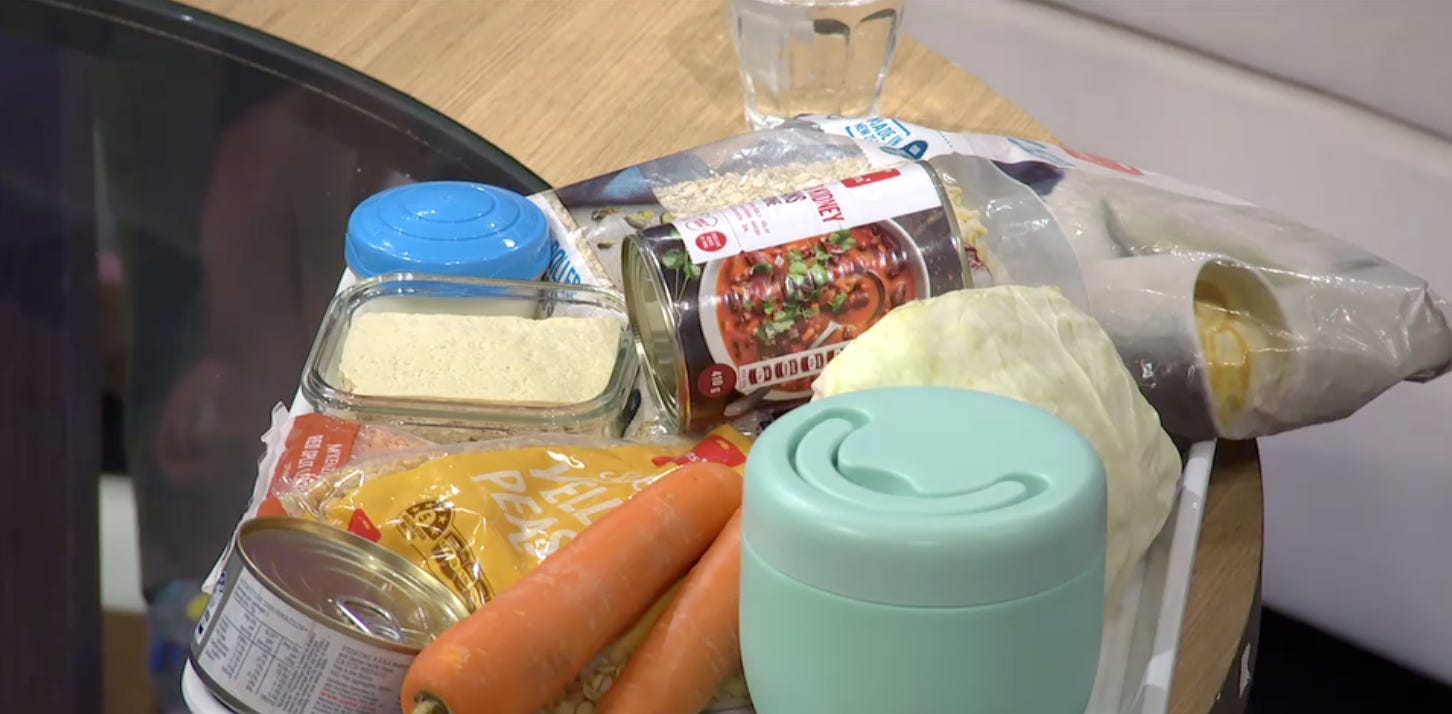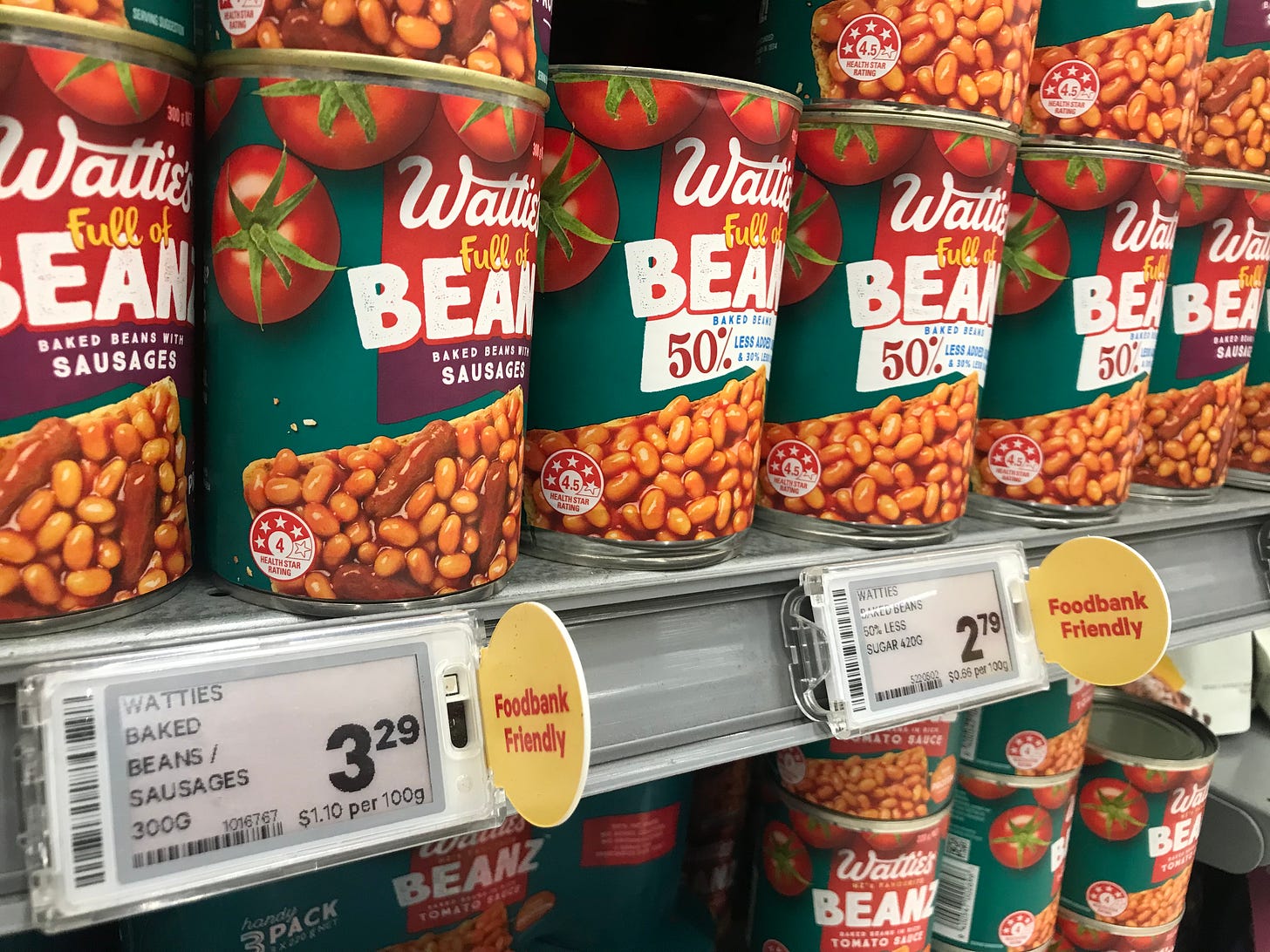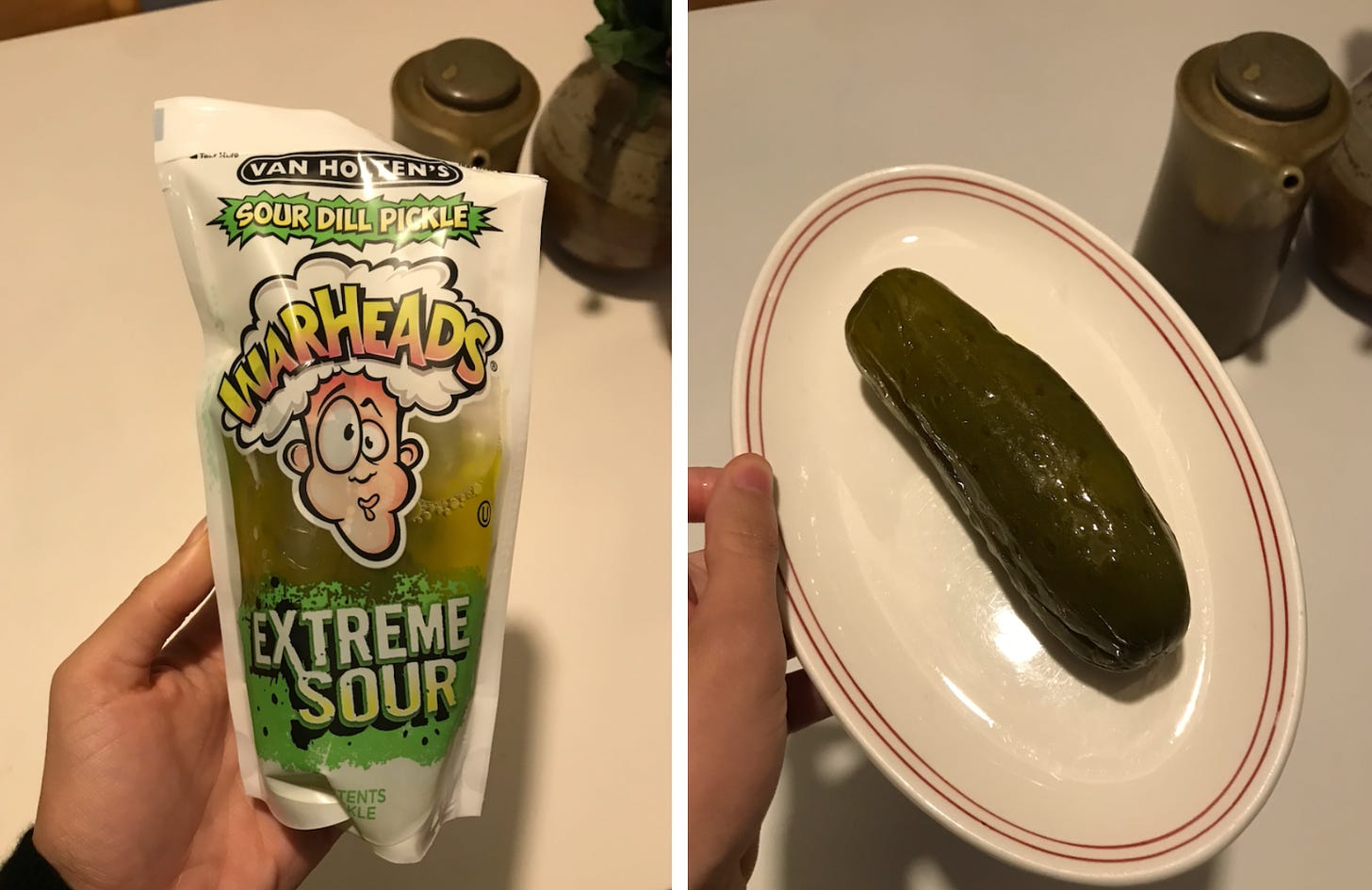Let them eat tinned fish and dried lentils
On the problem with budget food stories, the science of food textures and the sourest gherkin I’ve ever eaten.
Nau mai, haere mai. Welcome to The Boil Up, The Spinoff’s weekly food newsletter produced in partnership with Boring Oat Milk. Written by me, Charlotte Muru-Lanning. It’s lovely to have you here!
When TVNZ 1’s Breakfast sat a budget expert and a nutritionist – both with the best of intentions – behind a rather grim pile made up of two carrots, a sack of Pam’s rolled oats, two bags of dried pulses, half a cabbage, a tin of sardines, a container of tofu and a tin of kidney beans last week, they probably weren’t looking for a negative response from viewers. Yet that’s exactly what happened.
“It’s knowing the swaps and the alternatives,” proclaimed the nutritionist from the studio couch as she shared cost-cutting tips to help manage skyrocketing food prices. “A lot of this is about knowing how to cook.”
The premise of the morning television segment might have seemed innocuous enough to some, but it provoked a barrage of frustrated comments on social media. It’s little wonder people were so incensed – these kinds of stories are thoroughly ideological and in the eye of a global-cost-of-living-crisis storm, they can feel relentless. Many, it seems, are tired of being served budget eats and thrifty supermarket alternatives. And for good reason.
In a practical sense, this particular segment, along with many others in this vein, make little effort to recognise the reality of people’s everyday relationships with kai. Clearly, none of the food touted here is innately bad, in fact, for a good deal of us this food is exceptionally ordinary. For others though, adopting lentils over meat or tinned fish over fresh would mean parking vital cultural practices. As well, this approach ignores that children can be extremely picky eaters, or that plenty among us have allergies and food intolerances. Nor does it account for the fact that not everyone has the time to cook or to learn to make these kinds of foods. And that the spices, herbs and accoutrements to make this food taste delicious are absent from plenty of pantries. To suggest that people can so easily substitute their kai is to forget that for the vast majority, food means so much more than pure sustenance.
But there’s another, more complicated, piece of the puzzle here. It’s the thread of individualism that is pervasive in these kinds of cost-cutting food stories.
When I talk about the cost of living crisis, it's perhaps more accurate to talk about it as a feature of the ongoing inequality crisis, in which low-waged people continue to bear the bulk of the burden. So, while suggesting tinned beans for dinner might seem solely helpful in an immediate sense, it also runs the risk of normalising a world where many struggle to afford the basics. Meanwhile, the lucky among us continue to devour whatever and however much they please. It’s an approach that presents the cost of living crisis as a symptom of personal dietary decisions rather than an outcome of political decisions.
Naturally, that focus also sees the potential solutions land in the realm of individual choice rather than the far more useful approach: collective action. In a recent article on The Spinoff, Toby Boraman writes, “[from] the late 1960s to the early 1980s…the union movement used strikes to combat the effects on workers of chronic inflation and a deep economic crisis.” As he explains in the article, this tended to work pretty well.
Admittedly, it's much easier to approach our current cost of living crisis reality with stories that attempt to respond to immediate needs, by way of thrifty dinner inspiration or raisin-scattered porridge. But if we’re in the business of looking for actual solutions, we can’t ignore the far more complex landscape underpinning this. Should supermarkets be making more than $1 million in excess profits each day? Why are median wage earners paying more than double the rate of tax as the wealthiest New Zealanders? Is food inflation being driven by company profits? Is it fair that we’ve created a society where there is so much choice and variety, and yet so many can’t access that? Or, as I discovered on my weekend shopping trip, why do some supermarkets now have “foodbank friendly” labels on the shelves?
Still, I don’t believe that celebrating the potential of cheaper kai is always an endorsement of the status quo. There’s an evergreen value to sharing knowledge around more affordable ingredients and tips to avoid food waste. In fact, I’ve encountered plenty of food media that manages to provide useful tips and tricks without forgoing nutrition, convenience, culture and taste, and most importantly, without asking people to resort to gruel. Recently I’ve written articles which probably fit into the budget food story category – I hope they strike the right balance, but I’d be lying if I said it didn’t worry me that I was doing exactly what I’m critiquing here.
Counter this cost-cutting morning television segment with another TVNZ 1 story on the impact of the cost of living crisis on three pensioners. “I couldn't afford a piece of fish,” recounts one woman with tears in her eyes. “It makes me feel like I don't count any more, like I’m not managing my money enough and it makes me feel like I can't afford to eat healthy any more.” A heartbreaking reality within a country so plentiful with kai, and one that certainly won’t be solved solely by what we put in our individual shopping trolleys.
The Boil Up is brought to you in partnership with Boring Oat Milk
Made with a tough crowd in mind, Boring Barista Grade Oat Milk is smooth, creamy and delicious. Great for the pros in cafes and everyday milk stuff at home, it complements your brew by letting the espresso shine and holds its texture nicely when poured. Think of coffee as the lead singer while Boring is on drums. Head to boringmilk.com for an untapped supply of New Zealand made oat milk straight from the source. Check the box that says ‘Subscription’ and save 10%.
Weekly bites
Marlborough-based Kono Seafood has been sold to food manufacturing giant Talley’s. Kono NZ, which consolidates all of the food and beverage businesses of Wakatū Incorporation, announced the sale of its seafood arm yesterday morning. The seafood business, which produces and exports greenshell mussels, employs around 300 staff across its three sites in Blenheim, Golden bay and Havelock. Staff were shocked by the announcement, reported Stuff, and were concerned about the prospect of redundancies. RNZ reported that Kono NZ chief operating officer Andy Wotton said the company was working with Talley's to ensure employees were offered roles. Talley’s, which produces vegetable, dairy and seafood products, has chequered history when it comes to employment relations, health and safety and environmental practices.
On the topic of food costs and corporate profits, fast food operator Restaurant Brands’ total sales for the first quarter are up 12% on the previous year. The group, which operates KFC, Taco Bell, Carl’s Jr and Pizza Hut in four regions in the Pacific, said sales were at $308.6 million, up $33.2m on the year before. Among the New Zealand stores, sales were up 9.2%on the same time last year, and up 7.4% on a same store basis, to a total of $129.4 million. "Sales grew across all brands, largely driven by price increases and the easing of pandemic-related trading constraints," the company said.
Texture is pivotal to our experience of food, and yet the value attached to textures like squishy, chewy, gritty and so on differs vastly between people and cultures. The fascinating story of how texture affects taste and why our experience of that is so varied is the focus of a recent episode of food history and science podcast Gastropod. They delve into the anatomy of our tongue, languages, the molecular structure of food, our eating behaviour and more.
Jamaican-American performer and tireless activist Harry Belafonte died this week. Day-O (The Banana Boat Song), which he popularised, is one of the most iconic songs ever written about fruit, and in my opinion, certainly the most poignant on the politics of food. Moe mai rā e te rangatira.
A message from Duncan Greive, senior writer, podcast host and founder of The Spinoff. I founded The Spinoff to fill a hole in our media landscape – to create smart, original writing and content that looks at this country from a different angle. The only reason it exists today is because our members believe in us, and are willing to donate to keep our content free for all. Join us in making a difference to the local media landscape by becoming a member or making a new donation today.
The weekly snack
Van Holten’s Warheads Sour Dill Pickle, $4.99 from New World: The last time I ate one of these kinds of gargantuan bagged pickles I was in Poland. Alone, newly single, about $50 away from broke and eating a pickle on the streets of Warsaw. I finished that pickle solely out of politeness and made a mental note that I should probably steer clear of them going forward. That all changed this week when I spotted this Van Holten’s and Warheads (as in the sour lollies you find at the dairy) collaboration in the supermarket. The concept seemed all at once haunting and totally intriguing. I envisioned a chaotic amalgamation of the sweet and sour lollies absorbed by a gherkin. So, it was with great trepidation that I gave this “pouch pickle” a go yesterday evening. To my surprise, and relief, it was perfectly pleasant and far better than my Eastern European experience. Sour upon sour, yes, but otherwise crisp, crunchy and decidedly normal. If anything, I’m disappointed that it wasn’t a more deranged experience. 8.5/10.
Talk next week!
Hei kōnā mai, Charlotte

















